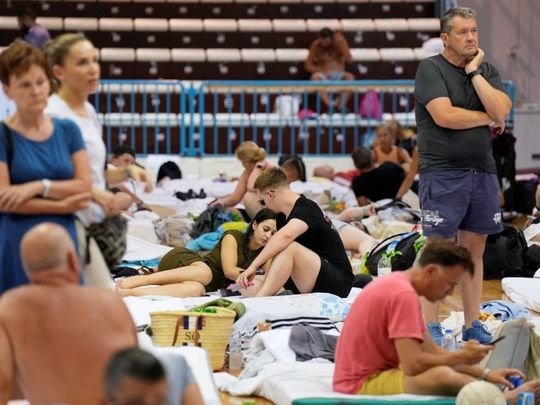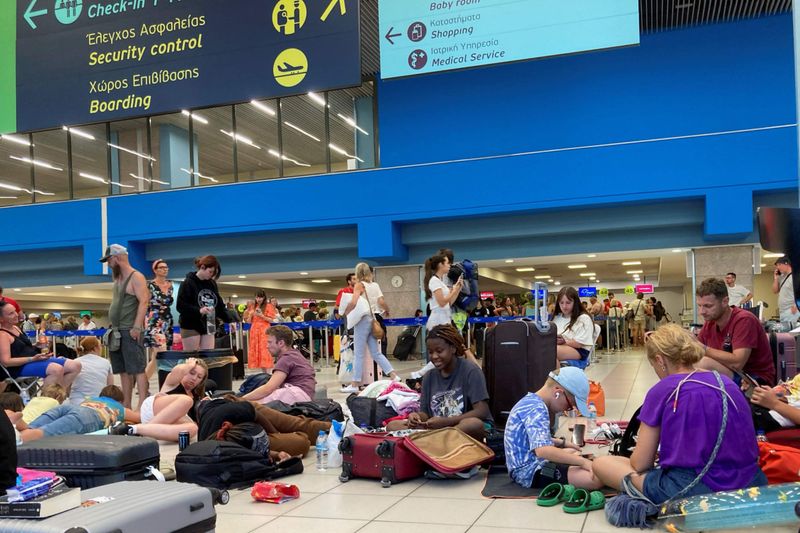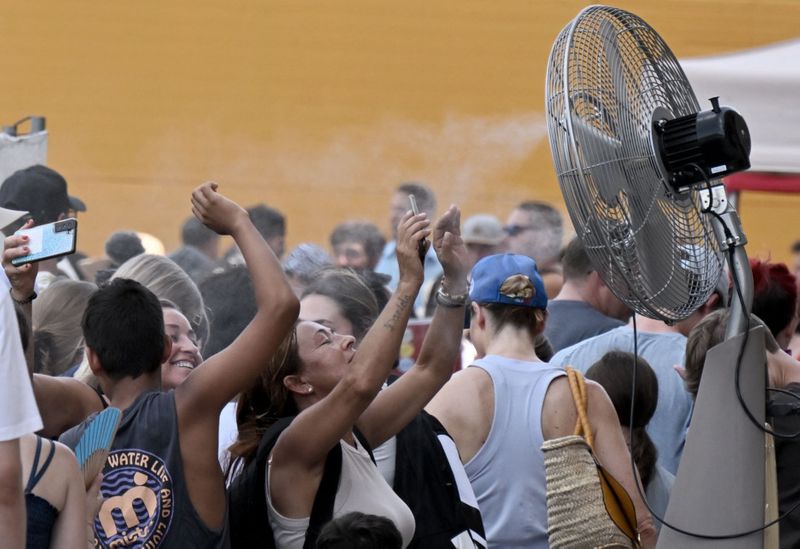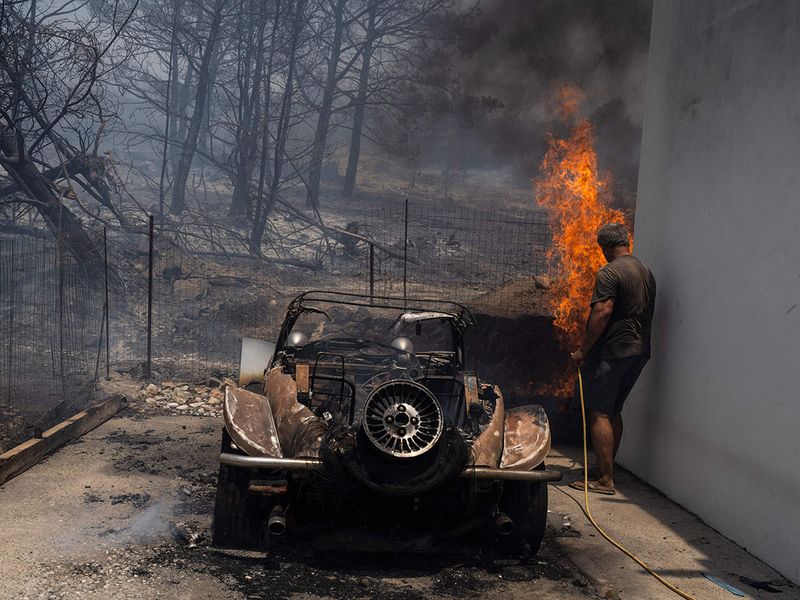
Athens: Wildfires are raging across Greece after about 19,000 people were evacuated from the island of Rhodes over the weekend, while record temperatures are forecast for Sardinia.
Over the past 24 hours, 162 fires were reported across Greece amid high winds and extreme heat. Authorities evacuated nearly 2,500 people from the Greek island of Corfu on Monday, including 59 rescued from a beach by the coast guard.
Tens of thousands of people have already fled blazes on the island of Rhodes, with many frightened tourists scrambling to get home on evacuation flights.
About 2,400 visitors and locals were evacuated from the Ionian tourist island of Corfu from Sunday into Monday, a fire service spokesman said, adding that the departures were a precaution.
As forest fires threaten the villages of Gennadi and Vati, a further evacuation order was issued for parts of Rhodes on Monday.

“We are at war,” Greek Prime Minister Kyriakos Mitsotakis told lawmakers in parliament on Monday. “The climate crisis is already here.”
Kelly Squirrel, a transport administrator from the United Kingdom, said police had ordered people from her hotel on Rhodes to evacuate.
“We had to keep walking,” she told AFP at the international airport. “So we walked for about six hours in the heat.”
Rhodes, which counted 2.5 million visitor arrivals in 2022, is one of Greece’s leading holiday destinations.
Greek television broadcast images of long lines of people, some in beachwear, lugging suitcases along the island’s roads on Saturday, when the evacuations were ordered.
Some 30,000 people fled the flames on Rhodes at the weekend, the country’s largest-ever wildfire evacuation.
Police said 16,000 people had been transported on land and evacuated 3,000 by sea. Others had to flee by road or used their own transport after being told to leave the area.

“We are exhausted and traumatised,” said Daniel-Cladin Schmidt, a 42-year-old German tourist waiting to be evacuated with his wife and nine-year-old son.
“There were thousands of people, the buses couldn’t pass, we had to walk for more than two hours,” he told AFP at Rhodes airport.
“We couldn’t breathe, we just covered our faces and moved forward.”
Holiday-makers and some locals spent the night in gyms, schools and hotel conference centres on the island.
In the departures hall of the international airport, AFP saw groups of tourists sleeping on the floor, surrounded by luggage.
“We had to lend a woman some of my wife’s clothes because she had nothing to wear,” Kevin Sales, an engineer from England, told AFP. “It was terrible.”
Extreme weather is devastating southern Europe this summer, from hailstorms and a tornado in Italy, to heavy rainfall and strong winds that left several dead in parts of the Balkans.

Despite the hottest ever June, followed by a raft of record temperatures from the US to China, Group of 20 energy ministers failed to find consensus on the phase-down of fossil fuels at a meeting in India.
Global warming, triggered by greenhouse gas emissions, is increasing the intensity and duration of summer heat waves across the Northern Hemisphere, raising questions over whether swathes of the planet are becoming uninhabitable.
Almost 1,500 people have been repatriated from Rhodes, mainly to the UK, Germany and Italy. That’s helped reduce the number of people needing temporary accommodation, after flight cancellations left tourists stranded on the Greek island when fire threatened hotels and homes at the weekend.
Rhodes popular for British visitors
The European Commission, the UK, France and Italy are assisting in the firefighting and rescue efforts. Eight jets and 10 helicopters are supporting efforts to quell the fire on Rhodes.
EasyJet Plc is providing two repatriation flights on Monday from Rhodes. Leisure carrier Jet2 Plc also said it would send the empty planes to the area to bring customers back to the UK.
TUI AG scrapped flights to Rhodes through July 25 and said it was sending in additional support staff for customers on the island. Ryanair Holdings Plc is allowing customers to book on earlier flights out of Rhodes free of charge.
Rhodes is particularly popular with British visitors, who accounted for nearly a quarter of all international air arrivals in June, according to data from Rhodes Airport. Germans and Poles were the second and third-largest groups to arrive by air last month.
The Greek civil protection ministry said the Rhodes evacuation was the largest in the country’s history caused by a wildfire.
The crisis has left Greece facing a dilemma, as many of its islands are dependent on visitors, especially during the summer. Tourism Minister Olga Kefalogianni told BBC Radio 4’s Today program that people should continue to fly to both Corfu and Rhodes.
Greece isn’t the only country troubled by wildfires, with parts of the south of France facing a very high risk on Tuesday, according to the national weather forecaster.
Cooler weather is set to continue in Northern Europe with temperatures in the UK, Germany, France and Nordic countries below seasonal averages. London will peak at 18C°, 5°C below seasonal averages according to forecaster Maxar Technologies Inc

The proportion of emergency-room visits linked to heat skyrocketed in Texas and surrounding states starting in June, according to Centers for Disease Control and Prevention data, with some weeks surpassing levels seen last year. Rates soared in other parts of the country, including the Southwest, in late June and July. Doctors in Arizona and Texas said it’s the worst summer they’ve experienced, with a higher number of patients coming in and some needing treatment for severe conditions like heat stroke, when high body temperatures can damage vital organs and sometimes lead to death.
Temperatures have set monthly and all-time records around the country in the past month, spiking well above 100F (38C) in many places. There’s little chance of relief soon: Most of the US has a high chance of warmer-than-normal temperatures through August 3, according to the Climate Prediction Center.
In Phoenix, where temperatures were on track to hit 110 or higher for a 22nd consecutive day on Friday, the Valleywise Health system has called in extra staff to handle its highest volume of patients since the pandemic.
Summertime heated-related illnesses are “not an uncommon problem,” in Phoenix, said Valleywise Chief Clinical Officer Michael White, “but the number of patients that we’re seeing now with heat exposures has risen.”
At least 18 people died of heat-related causes this year through July 15 in Maricopa County, which includes Phoenix, the county public health department said in a weekly report. A further 69 deaths were under investigation.
At Texas Health Presbyterian Hospital Plano, the emergency department had to implement a surge plan to bring in more staff, said Andrew Morris, chair of emergency medicine. Heat has contributed, he said, as well as higher rates of trauma cases in the summer. A return to hospitals and emergency rooms after patients had shied away during the pandemic is also contributing, he said.
The Texas Health system’s 20 emergency rooms saw 181 patients complaining of heat stroke and heat exhaustion in June, the most for that month in records going back to 2019.
Many patients have relatively mild illnesses, doctors said, including heat exhaustion and rashes from sun exposure. Others have had extreme cases of heat stroke, and may be given IV fluids or sometimes wrapped in specially designed bags filled with ice.
At Tampa General Hospital, several heat-related cases have been particularly concerning, said emergency-medicine physician Jason Wilson. Some patients had temperatures as high as 107, while others had third-degree burns from lying in the hot sun, which can happen when heat stroke alters a victim’s mental state.
Doctors sometimes take extreme measures in these cases, including implanting tubes that move cold water into a patient’s body, said Wilson, chief of the University of South Florida’s emergency medicine division, which is affiliated with the hospital.
It will be some time before the summer’s full toll is known, but it’s likely to be significant. The US saw 3,066 heat-related deaths from 2018 to 2020, according to the CDC.
While Wilson hasn’t seen the number of patients rise above past years, he said doctors are concerned and keeping an eye on the situation.
It’s “like a shark bite summer,” he said. “You kind of have to wait and see where things fall out.”
--- Bloomberg












